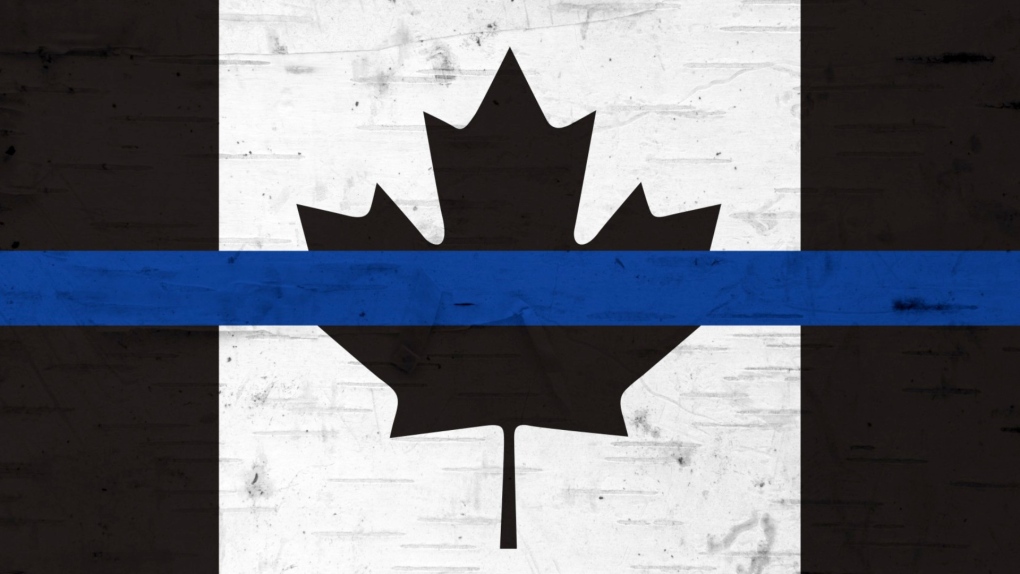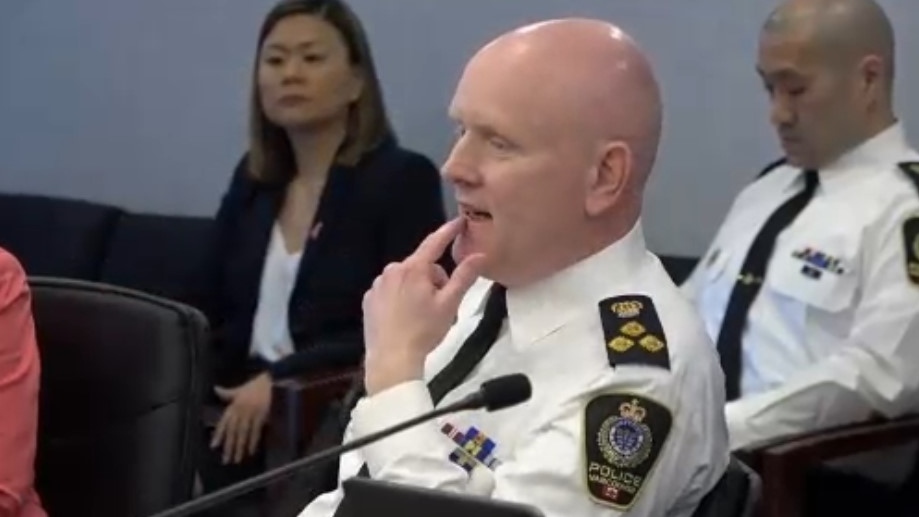Vancouver police not using thin blue line patches as white supremacist symbol, chief says
 A version of the thin blue line symbol is seen in an image provided by the Calgary Police Commission.
A version of the thin blue line symbol is seen in an image provided by the Calgary Police Commission.
The Vancouver Police Department has joined a growing list of law enforcement agencies grappling with how to address the use of thin blue line patches among members.
Last week, the city's police board heard a complaint dating back to November regarding an officer donning the patch – which features a black-and-white Canadian flag with a blue line through the middle – at an Indigenous land back rally in the downtown core.
"There was a white police officer who wore a white supremacist badge," reads the complaint. "There were many witnesses and photos to prove it."
There has been growing controversy over the patches in Canada and the United States, where various versions of the symbol have been featured at a number of political rallies – including those pushing back against the Black Lives Matter movement in 2020, and at the infamous Unite the Right white supremacist rally in Charlottesville, Va., in 2017.
Vancouver Police Chief Adam Palmer was called to respond to the complaint at last Thursday's board meeting, and denied any race-related motivation behind local officers' use of the insignia.
Palmer said the patch has "deep-rooted meaning" for police across North America, representing camaraderie among officers while also paying tribute to those who have died in the line of duty.
"They see service and sacrifice. They see esprit de corps as members of the policing community," the chief said. "So it does have strong meaning with police officers. It's a very sensitive issue. Officers wearing those patches are not wearing them as any kind of show of white supremacy or anything like that."
But Palmer acknowledged the controversy as well, suggesting that concerning associations have spilled over the border and affected perceptions of the symbol in Canada.
 Vancouver Police Chief Adam Palmer addresses a complaint about an officer wearing a thin blue line patch during a Vancouver Police Board meeting on Thursday, April 21, 2022.
Vancouver Police Chief Adam Palmer addresses a complaint about an officer wearing a thin blue line patch during a Vancouver Police Board meeting on Thursday, April 21, 2022.
He also noted that attempts to stifle the use of thin blue line patches have been met with fierce pushback.
Last month, the Calgary Police Commission issued a directive for officers to stop using the patch while on duty, citing the symbol's "contentious history with roots in division, colonialism and racism."
"People in our community have clearly expressed that the thin blue line patch on police officers makes them uncomfortable due to its history and current use by groups opposing racial equity," chair Shawn Cornett said in a statement on March 30.
"As policing evolves, so must its symbols. Discontinuing the use of a symbol that is undermining some Calgarians’ trust in the police is the right thing to do."
The officers' union balked, telling members to flout the directive, resulting in the Calgary Police Service pausing the requirement while officials attempt to navigate the tricky path forward.
 An RCMP officer wears a 'thin blue line' patch while enforcing a court injunction against old-growth logging protesters on Vancouver Island. (Torrance Coste)
An RCMP officer wears a 'thin blue line' patch while enforcing a court injunction against old-growth logging protesters on Vancouver Island. (Torrance Coste)
"You know, we went from having a few members in Calgary wearing it to now all the members in Calgary are wearing it because of certain decisions that were made," Palmer told the Vancouver Police Board. "In hindsight, probably some of those decisions could have been made perhaps with different considerations, and a little more sensitively."
The RCMP also issued a directive against the insignia in 2020, opening a rift with the National Police Federation – the union representing nearly 20,000 Mounties – which said the thin blue line represents the role officers play “providing a barrier between social order and chaos."
In Vancouver, the police department has a strict policy for officer's uniforms that's several pages in length, though Palmer said members have been allowed "a bit of leeway" to express support for a number of causes in the past, including pins acknowledging residential school victims.
He volunteered to prepare a report on the thin blue line patches, including their history and "misunderstanding or misappropriation," for a future meeting.
The Vancouver Police Board also suggested seeking a provincial decision on whether to allow or prohibit the symbols across B.C., rather than doing so at a city level.
CTVNews.ca Top Stories

'He's in our hearts': Family and friends still seek answers one year after Nathan Wise’s disappearance
It’s been a year since Nathan Wise went missing and his family is no closer to finding out what happened to him.
'My family doctor just fired me': Ontario patients frustrated with de-rostering
Dozens of Ontarians are expressing frustration in the province’s health-care system after their family doctors either dropped them as patients or threatened to after they sought urgent care elsewhere.
Ottawa pizzeria places among top 20 deep-dish pizzas in the world at international competition
An Ottawa pizzeria is being recognized as one of the top 20 deep-dish pizzas in the world.
Canada Post cracks down on Nunavut loophole to get free Amazon Prime shipping
Amazon's paid subscription service provides free delivery for online shopping across Canada except for remote locations, the company said in an email. While customers in Iqaluit qualify for the offer, all other communities in Nunavut are excluded.
Wildfire near Fort McMurray more than triples overnight, several evacuation alerts remain in place
The fire burning near Fort McMurray grew from 25 hectares to 5,500 hectares over the weekend.
Putin replaces Russian defence minister in rare cabinet shakeup
Russia’s President Vladimir Putin began a Cabinet shakeup on Sunday, proposing the replacement of Sergei Shoigu as defence minister as he begins his fifth term in office.
Man fatally 'slashed in the neck' in downtown Toronto, suspect outstanding
Police are searching for a male suspect after a man was “slashed in neck” on Sunday morning in downtown Toronto and died.
WATCH Dashcam video shows terrifying near-miss on two-lane northern Ontario highway
There were some scary moments for several people on a northern Ontario highway caught on video Thursday after a chain reaction following a truck fire.
Edibles, armchairs and adapters: Here are the recalls for this week
Health Canada announced various product recalls this week, including electric adapters, armchairs, cannabis edibles and vehicle components.































